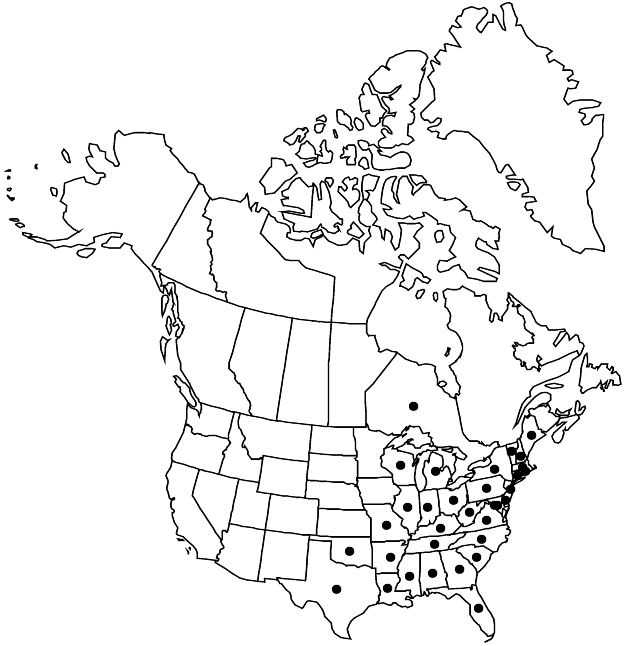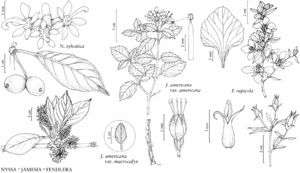Difference between revisions of "Nyssa sylvatica"
Arbust. Amer., 97. 1785.
FNA>Volume Importer |
FNA>Volume Importer |
||
| Line 28: | Line 28: | ||
|elevation=0–1100(–1600) m. | |elevation=0–1100(–1600) m. | ||
|distribution=Ont.;Ala.;Ark.;Conn.;Del.;D.C.;Fla.;Ga.;Ill.;Ind.;Ky.;La.;Maine;Md.;Mass.;Mich.;Miss.;Mo.;N.H.;N.J.;N.Y.;N.C.;Ohio;Okla.;Pa.;R.I.;S.C.;Tenn.;Tex.;Vt.;Va.;W.Va.;Wis.;c Mexico. | |distribution=Ont.;Ala.;Ark.;Conn.;Del.;D.C.;Fla.;Ga.;Ill.;Ind.;Ky.;La.;Maine;Md.;Mass.;Mich.;Miss.;Mo.;N.H.;N.J.;N.Y.;N.C.;Ohio;Okla.;Pa.;R.I.;S.C.;Tenn.;Tex.;Vt.;Va.;W.Va.;Wis.;c Mexico. | ||
| − | |discussion=<p>Nyssa sylvatica is widely planted as an ornamental, appreciated especially for its fall color.</p> | + | |discussion=<p><i>Nyssa sylvatica</i> is widely planted as an ornamental, appreciated especially for its fall color.</p> |
|tables= | |tables= | ||
|references={{Treatment/Reference | |references={{Treatment/Reference | ||
| Line 58: | Line 58: | ||
|publication year=1785 | |publication year=1785 | ||
|special status=Selected by author to be illustrated | |special status=Selected by author to be illustrated | ||
| − | |source xml=https://jpend@bitbucket.org/aafc-mbb/fna-data-curation.git/src/ | + | |source xml=https://jpend@bitbucket.org/aafc-mbb/fna-data-curation.git/src/8f726806613d60c220dc4493de13607dd3150896/coarse_grained_fna_xml/V12/V12_430.xml |
|genus=Nyssa | |genus=Nyssa | ||
|species=Nyssa sylvatica | |species=Nyssa sylvatica | ||
Revision as of 14:46, 18 September 2019
Trees, 5–30 m, proximal limbs spreading to slightly drooping, crown irregular; bark ± regularly longitudinally and transversely fissured; twigs puberulent. Leaves: petiole 5–15(–30) mm; blade obovate to elliptic, 5.5–12(–16) × (2.2–)3.5–6.5(–9.1) cm, herbaceous, base cuneate to rounded, margins entire proximally and 0–1(–3)-toothed distally, apex acute to acuminate, abaxial surface glabrous or puberulent, adaxial surface glabrous. Inflorescences: peduncle 3.6–4.3 cm, sparsely hairy or glabrous; staminate (1–)2–5(–7)-flowered, pistillate and bisexual (2–)3–5(–8)-flowered. Staminate pedicels present. Flowers: ovary glabrous. Drupes black to blue, glaucous, ovoid to ellipsoid, 8–12 mm, rough or smooth; stone 7–9 mm, with several low, rounded longitudinal ridges.
Phenology: Flowering spring.
Habitat: Well-drained sites, swamps (especially in northern part of range), saturated longleaf pine savannas, moist to mesic (or dry-mesic) woods.
Elevation: 0–1100(–1600) m.
Distribution

Ont., Ala., Ark., Conn., Del., D.C., Fla., Ga., Ill., Ind., Ky., La., Maine, Md., Mass., Mich., Miss., Mo., N.H., N.J., N.Y., N.C., Ohio, Okla., Pa., R.I., S.C., Tenn., Tex., Vt., Va., W.Va., Wis., c Mexico.
Discussion
Nyssa sylvatica is widely planted as an ornamental, appreciated especially for its fall color.
